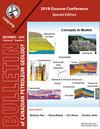Lithological and diagenetic restrictions on biogenic gas generation in Songliao Basin inferred from grain size distribution and permeability measurement
Q3 Earth and Planetary Sciences
引用次数: 6
Abstract
Abstract Organically rich immature source rocks occur commonly at shallow burial depths in Songliao Basin, NE China. This has led to the general assumption that there must be a large biogenic gas resource in these organic rich, shallow strata. However, except for a few small gas fields that are generally associated with biodegraded oil, only a small amount of biogenic gas has been discovered. In order to determine the geological factors controlling biogenic gas generation and accumulation, a suite of potential source rock shale samples from burial depth less than 1600 m was analyzed for organic composition, grain size distribution and permeability. The results show that selected samples are organic rich and thermally immature. The grain size analysis shows a mixed distribution of silt and clay with D10 generally below 1.6 μm. The measured permeability values are generally below 1 μd under in situ stress conditions with pore throats that are most likely smaller than that of methanogenic bacteria. Very low permeability and very small pores resulting from compaction and diagenesis restrict bacteria movement and activity, limit nutrient transport, diminish space availability, and lead to a reduced biodiversity. Currently, no microbes can survive in these Cretaceous shales even though the shales never reached geopasturization temperatures and there is sufficient substrate. Biogenic gas generation is inferred to be restricted to near surface strata while elsewhere in this succession methanogenesis has ceased, which significantly reduces the exploration potential for biogenic gas.松辽盆地生物气成藏的岩性成岩制约因素研究
松辽盆地浅埋层中普遍发育富有机质未成熟烃源岩。这使得人们普遍认为,在这些富有机质的浅层地层中一定存在大量的生物气资源。然而,除了少数通常与生物降解油有关的小型气田外,仅发现了少量生物气。为了确定控制生物气生成和成藏的地质因素,对埋藏深度小于1600 m的一套潜在烃源岩页岩样品进行了有机质组成、粒度分布和渗透率分析。结果表明,所选样品有机质丰富,热未成熟。粒度分析显示粉砂与粘土混合分布,D10普遍小于1.6 μm;在地应力条件下,测得的渗透率值一般小于1 μd,孔喉极有可能小于产甲烷菌的孔喉。压实作用和成岩作用导致的极低渗透率和极小孔隙限制了细菌的运动和活动,限制了营养物质的运输,减少了空间的可用性,导致生物多样性减少。目前,这些白垩纪页岩中没有微生物能够存活,即使页岩从未达到地球温度,并且有足够的基质。据推测,生物气的生成仅限于近地表地层,而在该演替的其他地方甲烷生成已经停止,这大大降低了生物气的勘探潜力。
本文章由计算机程序翻译,如有差异,请以英文原文为准。
求助全文
约1分钟内获得全文
求助全文
来源期刊

Bullentin of Canadian Petroleum Geology
Earth and Planetary Sciences-Geochemistry and Petrology
CiteScore
2.50
自引率
0.00%
发文量
0
期刊介绍:
The Bulletin of Canadian Petroleum Geology is a peer-reviewed scientific journal published four times a year. Founded in 1953, the BCPG aims to be the journal of record for papers dealing with all aspects of petroleum geology, broadly conceived, with a particularly (though not exclusively) Canadian focus. International submissions are encouraged, especially where a connection can be made to Canadian examples.
 求助内容:
求助内容: 应助结果提醒方式:
应助结果提醒方式:


